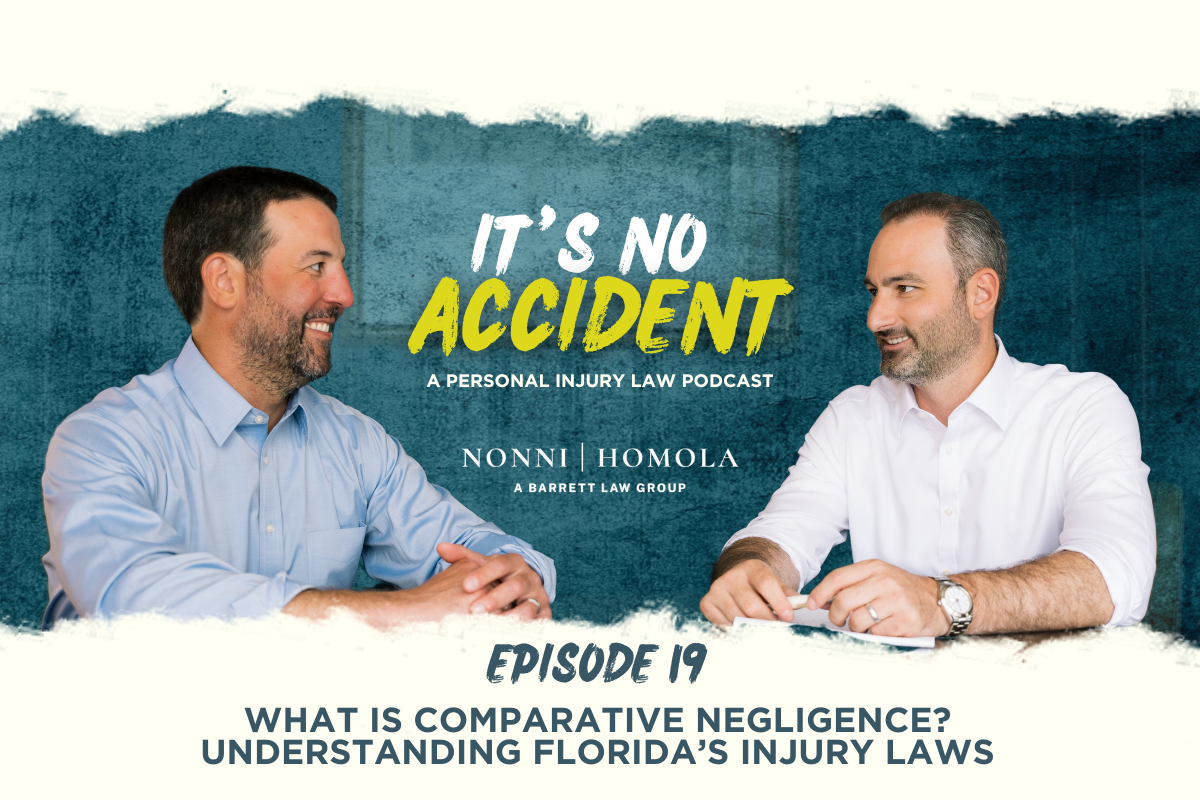
Episode Description
In this episode of It’s No Accident, Jaeson and Mark unpack the concept of comparative negligence, how fault is divided between parties in a case, and what that means for clients seeking compensation. They explain the big change in Florida law: if you’re found more than 50 percent at fault, you now get nothing, a major shift from the old system.
With real-life stories and straight talk, Jaeson and Mark reveal how this impacts the cases they take, the tactics defense lawyers use to blame victims, and how they help clients fight back, especially in tricky slip-and-fall cases.
Episode Transcript
We talk a lot on this show about negligence. It’s the foundation of what we do for a living. We’ve discussed how negligence is a choice, what the elements of negligence are, and how we prove them. But one topic we haven’t covered in depth is comparative negligence.
It’s something that can come up in any case we handle, and it’s important because many of our clients aren’t aware of it or how it can impact the value of their case, or what constitutes a fair settlement.
The easiest way to think about comparative negligence is through the lens of a trial. When a case goes to trial, the jury typically answers a series of questions on a verdict form. One of those questions often asks the jury to apportion fault between the plaintiff and the defendant. For example, if there’s one plaintiff and one defendant, the jury can assign a percentage of fault to each party—so long as the total equals 100%. It could be 50/50, 80/20, 60/40—whatever the jury thinks is fair based on the evidence.
Until 2023, even if the jury found the plaintiff to be 60% at fault, they would still recover 40% of the total verdict. So, if the jury awarded a million dollars but found the plaintiff 60% at fault, the actual judgment would be $400,000.
That structure gave clients some protection—even if they bore a significant share of the fault, they still recovered damages. But in 2023, Florida passed new tort reform legislation, House Bill 837, which changed everything.
Now, under the new law, if the plaintiff is found to be more than 50% at fault, they recover nothing—zero. So, using that same million-dollar verdict example, if the jury finds the plaintiff 51% at fault, they don’t get $490,000—they get nothing.
That’s a huge shift. It impacts how we evaluate new cases, especially those that involve close calls on liability. Before, we might take a case with some risk and fight to make sure our client received at least partial compensation. Now, without that safety net, taking a case where there’s a real chance a jury could assign more than 50% fault to the plaintiff is far more difficult.
And to be honest, the old system seemed fairer. If a jury finds the plaintiff 51% at fault, that still means the defendant was 49% responsible—yet under the new law, they’re not held accountable at all. They walk away without paying anything.
What’s interesting is that it doesn’t go both ways. If our client is found to be 30% at fault, the defendant only pays 70%. But the reverse isn’t true—there’s no requirement for the defendant to pay the full amount if the plaintiff’s fault is minor. The imbalance creates situations where defendants escape liability entirely, even when they bear nearly half the blame.
We also have to deal with the defense strategy of blaming the victim. It’s common in personal injury litigation. Defense attorneys are trained to shift as much fault as possible onto the plaintiff, even in cases where it seems unfair. They’re good at it—and juries often buy into those arguments, particularly in slip-and-fall or trip-and-fall cases.
In almost every slip-and-fall trial I’ve seen, there’s at least some percentage of fault placed on the plaintiff—for not watching where they were going, wearing the wrong shoes, or some other reason. Unless the defendant truly upsets the jury, there’s nearly always a finding of comparative negligence.
We now have to be much more selective in the cases we take. It’s hard to explain to a client that we can’t help them because there’s a risk a jury might assign just 51% fault. But that’s the legal reality now.
At least Florida still allows recovery at 50/50. In Georgia, for example, if the jury finds both parties equally at fault—50/50—the plaintiff gets nothing. That’s even harsher.
Some states still follow pure contributory negligence rules, meaning if the plaintiff is even 1% at fault, they recover nothing. That’s an extreme approach and, in our view, not a fair one.
Comparative negligence comes up in specific types of cases more often than others. You’re less likely to see it in a rear-end collision—though even in those cases, defense attorneys may argue the plaintiff stopped suddenly or unexpectedly. You’ll hear that same language echoed in depositions because it mirrors statutory defenses, and it’s clear defendants have been coached.
But in slip-and-fall cases and intersection collisions, comparative negligence is a central issue. In intersection cases, it’s often a “he said, she said” situation—who had the green light, who rolled through the stop sign, etc.
Defense attorneys will focus heavily on things like what shoes the plaintiff was wearing, whether they were looking at the ground, or whether they should have seen the hazard. We combat that by anticipating those arguments. For example, if shoes are likely to be a point of contention, we ask our clients to stop wearing them, take photos, and sometimes preserve them as evidence.
What we look for in footwear are shoes with rubber soles and visible tread—athletic shoes or sneakers are ideal. Loafers with leather soles or worn-out sandals give the defense more to work with.
I remember a case where a local plaintiff’s attorney took a slip-and-fall case to trial. The defendant, a large retailer, focused entirely on the fact that the plaintiff was wearing sandals. In closing, the plaintiff’s attorney told the jury, “We live in Florida—sandals could be considered the state shoe.” The jury found in favor of the plaintiff, assigning 100% fault to the defendant.
That makes sense. Most jurors likely wear sandals or flip-flops themselves. Just because someone is wearing everyday footwear doesn’t mean a business owner is off the hook for failing to clean up a dangerous condition.
Another common defense is, “You weren’t watching where you were going.” At first, that sounds like a good argument—until you really think about it. When you walk through a grocery or retail store, you’re naturally looking at the shelves, not the floor. That’s exactly what stores and product manufacturers want. They spend huge amounts of money designing eye-catching packaging and arranging items at eye level to draw attention.
So how can a store argue that you should’ve been looking at the ground instead of where they’re spending thousands of dollars trying to get you to look? It’s contradictory and illogical.
And let’s be honest—everyone gets distracted. I’ve nearly tripped myself while walking and talking to someone, not noticing something in my path. That doesn’t make me careless; it just makes me human.
All of this underscores the importance of understanding comparative negligence and how it affects personal injury cases. It’s not just about whether someone was hurt, but how the fault is distributed—and under the new law, that distribution could mean the difference between full compensation and nothing at all.


